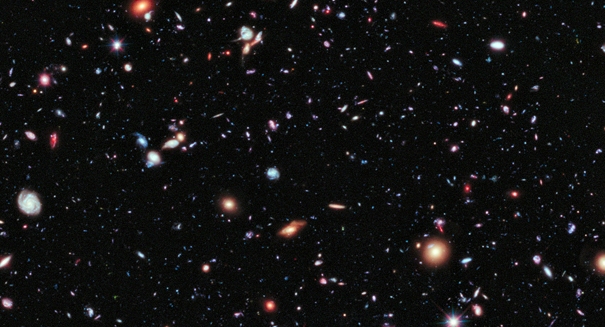
Observations of a nearby "starburst" galaxy are allowing Johns Hopkins researchers to understand the origins of light using the Hubble Space Telescope.
Where did light come from and how did it start? A compact star-producing galaxy 3 billion light-years away is shedding light (literally) on the origin of light in the universe.
The galaxy, named J0921+4509, is similar to the Milky Way in that there are dense clouds of gas that form stars. These gas clouds have holes that leak radiation, producing light that pierces through the galaxy’s darkness.
The holes in the gas clouds are crucially important for the production of light. Many star-forming galaxies are trapped by their own gas, but J0921+4509’s clusters of holes allow radiation to leak out. It’s a highly productive galaxy, creating 50 solar masses’ worth of stars per year- 33 times the number of stars that our Milky Way galaxy produces each year.
According to lead author Sanchayeeta Borthakur of Johns Hopkins University, “The high density of stars in a compact region in J0921+4509 results in an explosion-like feedback that is able to create the gaps.”
Scientists have long theorized that following the Big Bang, any radiation produced was rapidly swallowed up as hydrogen gas cooled, pairing up into protons and electronics. This would have resulted in the galaxy being “dark,” as nothing could be seen through telescopes. However, a phenomenon called the Lyman continuum would have scattered the electrons by reionizing the hydrogen gas. The galaxy would then be visible to astronomers once again.
Using the NASA Hubble Space Telescope, Borthakur and her team were able to observe the birth of stars in J0921. Unlike most galaxies, the stars were packed so tightly together that small holes formed, allowing the crucial radiation to escape. The results are significant for understanding how light formed after the Big Bang; radiation leaking from these small holes could have ionized the neutral hydrogen that blocked out visibility.
J0921 isn’t the only galaxy leaking radiation, but it’s fairly close to us; at 3 billion light-years away, it’s much closer than earlier galaxies 13 billion light-years from Earth. J0921 provides astronomers with a detailed picture of how radiation escapes from small holes widened by scorching solar winds. Of the numerous “starburst” galaxies currently studied, J0921 provides ten times as much radiation.
“This is the direct evidence of how the galactic feedback via winds can lead to conditions that allow Lyman continuum to escape,” said Borthakur. “This tells us about the physics of star formation and its feedback in the epoch of reionization and solves the decades-old mystery of how Lyman continuum photons can escape through the cold cloud cocoon enveloping star-forming regions.”
Her study was published this week in the journal Science.
Leave a Reply